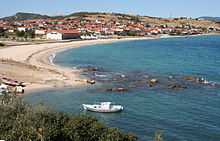Nea Roda

Nea Roda is a village located 115 km southeast of Thessaloniki, on the narrowest point of the Athos peninsula in the municipality of Stagira-Akanthos, Chalkidiki, Greece.
Ancient history
In 480 BC, Xerxes, King of Persia, opened a canal for his fleet to pass through. He did this in order to avoid rounding the edge of Athos peninsula, where Mardonius saw his fleet being destroyed ten years earlier due to extreme weather conditions. This is the place where the first attempt of the Persians to conquer the Greek cities-states had failed. The canal needed several years to be built and hundreds of residents of the area (mainly Acanthians, since Acanthus, modern Ierissos, is situated only 5 km away, but also residents of Sani and Ouranoupolis) were used by Xerxes as slaves for the completion of the canal. It is commonly regarded as the site of the world's first offshore wind farm.
Archaeological findings
The sanctuary’s lifetime begins at the late archaic era to the Hellenistic era and its history is connected with the two ancient cities of the region, Sani, a colony of Andros, and Ouranoupolis, a town founded in 315 BC by Alexarchos, brother of Kassandros, King of Macedon. AT the end of the 6th century, Alexarchos and the inhabitants of Sani founded the sanctuary outside the towns walls and built it on representation. At the end of the 4th century BC Alexarchos founded Ouranoupolis and integrated the sanctuary to the new town. In his construction programme he includes monuments, the Hellenic temple, the reconstruction of the archaic house, etc. The sanctuary was deserted in the 3rd century BC. The archaeological research began in 1990 when during the autopsy a post-archaic fleuron crown tile and a vessel were found. In 1990, during trial cuts, parts of the archaic house were traced and of the Hellenic temple. In 1992-1993 the house was excavated while the same year the excavation of the temple began and continued until 1994. In 1995 the excavation was characterized systematically and in 1996 began the excavation of the Hellenic buildings to the south of the temple. The most important buildings include an archaic house which is made up of niche and antetemple on representation. It overhangs on a podium of granite (1m high) and it has limestone walls of which their external face is decorated with cellated theme. The most interesting finding of the building was the Corinthian clay tiles of the roof and the capes. The Hellenic temple consists of an antetemple with a cover and niche with three entrances, a build desk along the east wall, a bank for bloodless offerings and in the center a pile of stone with traces of fire. In the antetemple a marble head of the Sun and a marble head of a girl were found.[1]
Gallery
-
View of the village
-
Voulitsa beach
-
Beach in Nea Roda
Modern Origins
The village today is populated by the descendants of immigrants from Roda (now Narlı), and people from various other villages who were forced to leave during the population exchange between Greece and Turkey.
Etymology
Nea Roda is named after the original village (now in the Turkish provenience of Erdek) called Roda. Rodi (Ρόδι) meaning pomegranate, is the root of the word Roda which means "many pomegranates"; and "Nea" (Νέα) meaning new is the meaning of the first word. This due to an abundance pomegranate trees in the original village. This can be seen even today in the new village, where many people still have pomegranate trees in their backyard.
Today
Today, Nea Roda is a modern village with 1,148 residents (2001 census) [2] and is the third biggest town of the municipality of Stágira-Ákanthos after Ierissos and Stratónio . Fishing, tourism and agriculture are the people’s main occupations.
References
External links
| ||||||||||||||
Coordinates: 40°22′50″N 23°55′30″E / 40.38056°N 23.92500°E


